Answering the Call for Extreme Tires
Robert Frost concerned himself with which road to take, but in some cases the more important question may be which tires to use. At times, the choice of tire can mean the difference between mission complete and mission failure, or even between life and death.
That might sound overly dramatic, but imagine being stranded on the moon 1,000 miles from home base, because a tire on the lunar rover popped. Or imagine being trapped in the middle of intense crossfire during wartime because bullets or shrapnel punctured the tires on your vehicle. Extreme situations often call for extreme innovation, even in the tire world.

Apollo 17 mission commander, makes a short checkout of the Lunar Roving Vehicle. 1972. Photo by Geologist-Astronaut Harrison H. Schmitt, Lunar Module pilot.
Image courtesy NASA.
Designing a tire that can withstand multiple punctures in addition to being high-performance, efficient, high capacity, and long lasting is a challenge. Previous lunar rovers had wire mesh tires made from zinc-coated piano wire, and the tires on military vehicles are often outfitted with special inserts that enable them to drive on a flat tire. However, the demands on tires for both types of vehicles are rising, requiring tires that can support more weight and travel further under stress.
In response to this challenge, researchers and engineers have gone back to the drawing board. Teams of experts in physics, materials science, tire design, the lunar surface, military vehicles, and other areas are working together to answer questions such as:
- What is the temperature range of the environment?
- What kind of surfaces will the tire travel on?
- What types of damage might the tire encounter?
- What materials can withstand the environment?
- How much weight does the tire need to support?
- How far does it need to travel?
- How long does the tire need to last?
- How fast does the vehicle need to be able to travel?
- What kind of design can support these requirements?
Additionally, all tires produce vibrations, noise, and heat as a result of the friction between the wheels and the surface on which they are traveling. But how much is too much?
In the last several years tire companies have developed a few promising prototypes for these extreme applications, some working in partnership with NASA. From a distance these tires may not look very different than the more than 300 million tires that are discarded annually in the United States, but a closer look reveals that these tires are not filled with air, and in some cases do not even use rubber.
In 2005 Michelin introduced the Tweel (think tire plus wheel), making headlines for its promising results. The Tweel consists of a central hub connected to a rigid outer rim by flexible spokes. The spokes and hub are made of plastic structures that deform when the tire goes over rough terrain. This enables a large portion of the tire to stay in contact with the surface even over uneven terrain, which provides traction and stability. The deformable hub and spokes also act as shock absorbers that help reduce the vibrations felt by the vehicle. Additionally, the tire functions well even if some of the spokes are damaged. At high speeds the Tweel has run into some problems with noise, vibration, heat, and wear. Currently, the plan is to introduce it in smaller vehicles first, such as scooters, small construction equipment, and wheelchairs. NASA is interested in applying the Tweel technology to lunar rovers, and in 2009 a small prototype of the new lunar rover drove in President Obama’s inaugural parade on Tweels.
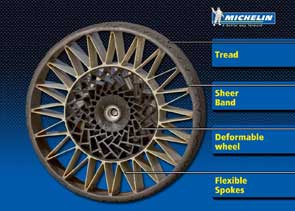 |
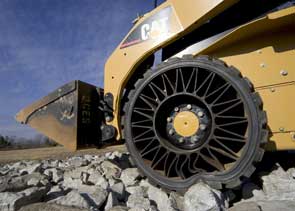 |
The Tweel design (left) will likely be introduced in light vehicles such as the Caterpillar® skid loader (right) and scooters before heavy military vehicles.
(c) 2011 Michelin North America, Inc.
Under a contract with the U.S. Army Research Laboratory, Resilient Technologies LLC and the University of Wisconsin–Madison's Polymer Engineering Center are working on a next generation tire for the Humvee. The tire is made of polymers and has the interior structure of a honeycomb. The honeycomb structure can support heavy loads and has lots of room for shrapnel to pass through, while still offering a relatively smooth ride. Additionally, if as much as 30% of its cells are damaged, the tire suffers little performance loss. Humvees can currently travel on a flat tire because of their insert design, but testing shows that the honeycomb design enables them to travel significantly faster and further. Resilient Technologies is aiming to have these tires available by the end of 2011.
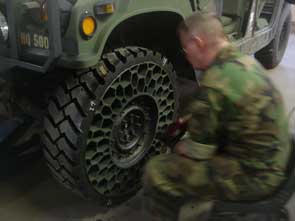 |
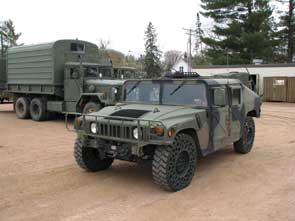 |
A Humvee outfitted with Resilient Technologies honeycomb tire for testing.
Images courtesy of Resilient Technologies, LLC.
Inspired by the wire mesh tires of the Apollo lunar rovers, a collaboration between the NASA Glen Research Center and the Goodyear Tire & Rubber Company resulted in a tire made entirely from springs. Each Spring Tire consists of 800 helical (coiled) springs that are woven together by hand. As the tires travel over rough terrain, the springs flex and relax in conjunction with changes in the surface. The springs are woven in such a way that they can support heavy loads and continue functioning even when some of the springs are damaged. This design produces little heat and little energy loss, and is not affected by vast temperature differences like those between night and day on the moon. In 2009 the Spring Tire was installed on NASA’s lunar test vehicle, which had a successful ride through the Johnson Space Center Planetary Analog Test Site, (aka “rock yard”).
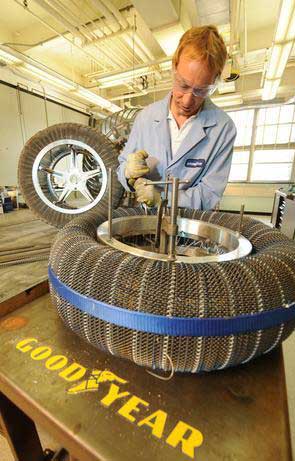 |
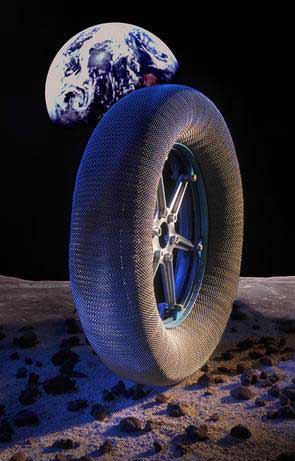 |
Each Spring Tire is made by hand using hundreds of springs.
Images provided by The Goodyear Tire & Rubber Company.
Airless tires like these provide exciting possibilities for military and space applications, but also for the average consumer. Tire blowouts can be very dangerous and few things are more frustrating than a flat tire on the side of a busy highway in the rain. However, much work needs to be done to hone the designs and make them economically viable options. It will likely be ten to twenty years before tires like these are available to the public, so don’t get rid of your tire jack just yet.














